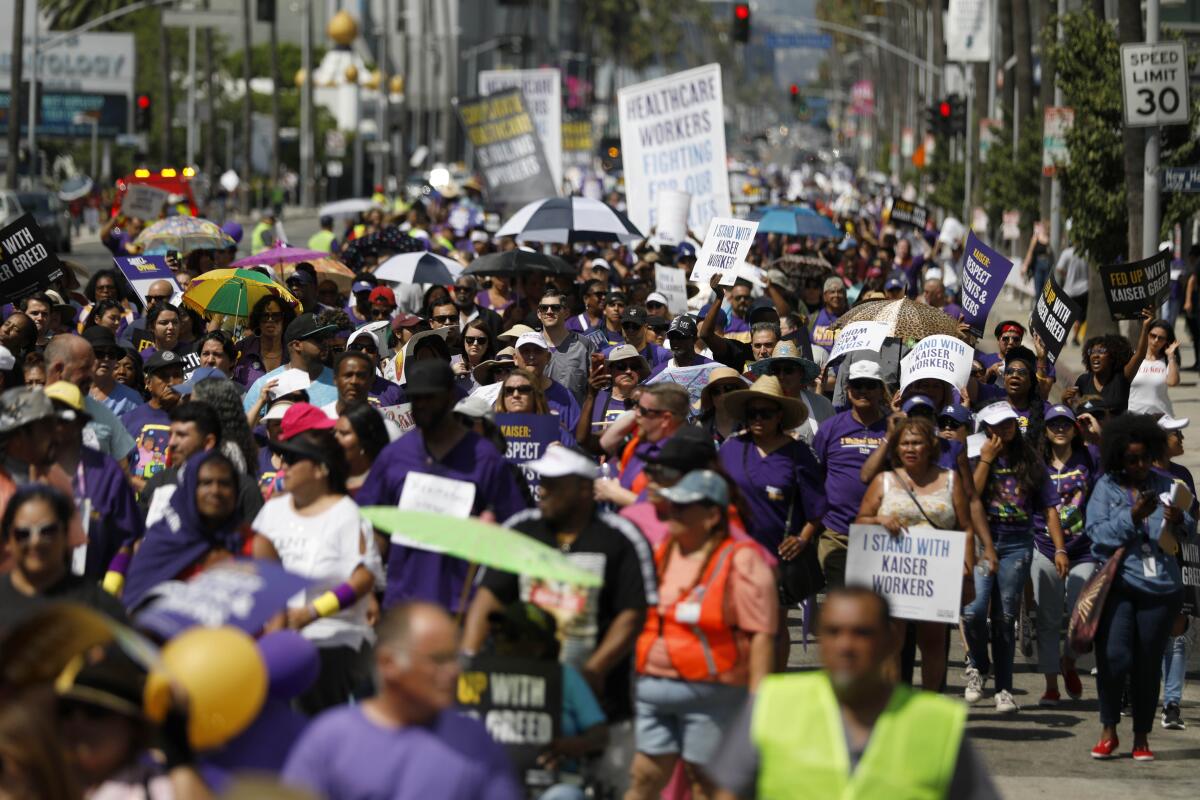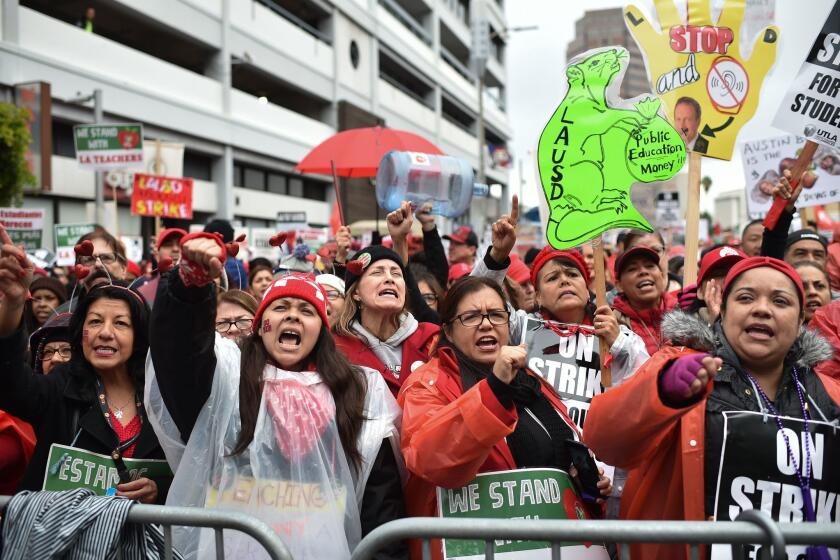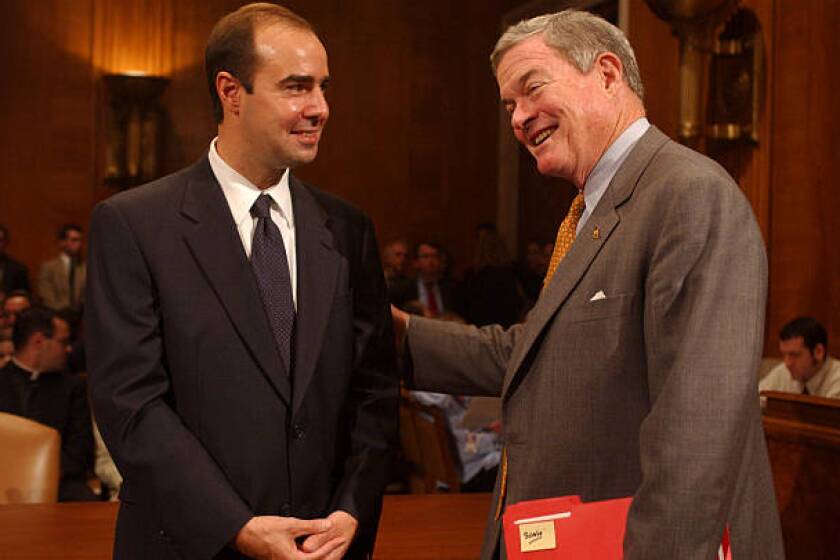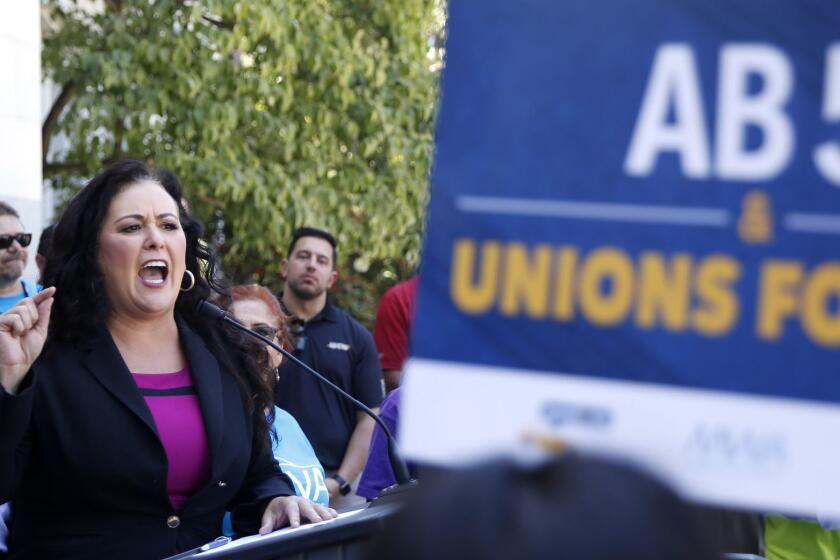Kaiser’s bitter contract talks could jeopardize its 20-year partnership with labor

- Share via
For more than two decades, Kaiser Permanente and most of its major unions enjoyed a relationship that was the envy of the U.S. healthcare industry — indeed, almost every industry.
The heart of the relationship was a Labor Management Partnership first reached in the mid-1990s. The partnership has brought to 165,000 unionized employees wages and benefits that have remained at or above industry standards, as well as a voice in decision-making in Kaiser’s hospitals, clinics and laboratories.
Kaiser committed not to fight unionization drives at its nonunion shops and to accept limits on layoffs, and received in return more than 20 years of relative labor peace.
There’s a lot of cynicism and frustration across the workforce that what was once a model partnership has become just a public relations tool for Kaiser.
— Dave Regan, SEIU-United Healthcare Workers West
But now there’s reason to wonder how much longer the Labor Management Partnership can survive. Last year, Kaiser added a provision to the partnership terms forbidding signatories to “pursue, sponsor, or support legislation or ballot initiatives ... the primary purpose of which is to harm another member of the Partnership.” Violators could be expelled from the partnership.
The language was aimed directly at the largest member of the 33-local Coalition of Kaiser Permanente Unions, which has represented the labor side of the partnership. That’s the Service Employees International Union-United Healthcare Workers West, which sponsored an anti-Kaiser ballot initiative in 2018 and has been taking an increasingly combative stance against the company in its current contract negotiations.
Union membership has been declining for decades. Can labor unions be revived? The answer is yes... if.
The revision helped to trigger discontent with the SEIU within the labor coalition. In March 2018, as a result, 22 locals split from the coalition, forming an Alliance of Health Care Unions that has accepted the revised partnership terms.
The coalition is now down to 11 locals mostly affiliated with the SEIU, though it represents the larger group of Kaiser workers — 83,000, as opposed to 49,000 within the Alliance unions. Although the Alliance unions reached a contract agreement last year, the SEIU-UHW remains locked in increasingly acrimonious contract talks with the giant not-for-profit hospital and insurance company. Last month, more than 37,000 Kaiser employees who are members of the SEIU-UHW voted to allow their leadership to call a nationwide strike if no contract is reached by Oct. 1. The result could be a walkout by more than 80,000 Kaiser employees.
This all signifies that the two-decade peace largely brought about by the partnership may be in jeopardy. Kaiser and the Alliance unions are determined to continue the partnership, but they’re uneasy about the UHW’s tendency to question the partnership’s continued relevance. Says UHW President Dave Regan, “There’s a lot of cynicism and frustration across the workforce that what was once a model partnership has become just a public relations tool for Kaiser, that it’s not a genuine partnership anymore. What’s clear to the coalition is that Kaiser’s definition of what the relationship is has changed, and not for the better.”
The Alliance disagrees. “We feel our contracts have continued to thrive,” says Denise Duncan, head of United Nurses Assns. of California/Union of Health Care Professionals, which helped form the new Alliance and reached contract terms with Kaiser last year. “We feel that our work-life balance has improved, and nurses have been able to have a better say on what patient care should look like. We feel we made the right decision” to stay with the partnership.
Trump’s evisceration of labor protections will continue under Labor Department nominee Scalia
In the broadest terms, what’s at issue are the strategy and tactics of organized labor at a time when unions are reckoning with a long slide in their membership and facing unexampled hostility from the federal government and many state governments. The Labor Management Partnership has long been seen as a promising alternative to the traditional models in which labor battled to organize workers under pressure from management anti-union campaigns, then held contract negotiations under the shadow of strike and lockout threats. The UHW’s policy has tended toward returning to the old models.
The goal of Kaiser’s Labor Management Partnership was to create a system in which both sides could work out their differences in collaboration, not conflict. That hasn’t always succeeded in practice, observes Adrienne Eaton, dean of the Rutgers School of Management and Labor Relations and coauthor of a 2009 study of the partnership’s first decade.
“There certainly have been bumps along the way,” Eaton told me. “It hasn’t always been a labor relations utopia by any means.” But during the partnership period, she says, at Kaiser “collective bargaining agreements have been quite positive for the workers, with industry-leading wages and benefits, and the opportunity for healthcare workers to participate in making the work better. It’s hard to ignore that.”
Uber, Lyft and Doordash will spend $90 million to undercut a California employment law.
What’s especially ironic about the challenges facing the partnership is that the SEIU was a driving force in creating the arrangement. In the mid-1990s, Kaiser Permanente faced a financial crisis that seemed destined to lead to labor chaos. The healthcare firm was in the red by more than $250 million. Its standards for patient care were slipping and widespread layoffs appeared to be looming. As Steven Greenhouse observes in his new book on labor history, “Beaten Down, Worked Up,” John Sweeney, then the SEIU president and a future head of the AFL-CIO, told then-Kaiser Chief Executive David Lawrence that “Kaiser had two choices: war or partnership.”
The result was “the largest, most complex, ambitious, and broad-based labor-management partnership in U.S. history,” as it was described by Eaton and three coauthors in “Healing Together,” the 2009 study of the partnership.
The Labor Management Partnership has not always been to everyone’s taste. From the inception in 1997, it has been shunned by the California Nurses Assn., which represents about 21,000 Kaiser nurses and nurse practitioners. “We believe it undermines the voice of nurses, who are obligated to speak on behalf of the patient, not the employer,” says Chuck Idelson, a spokesman for the nurses union. “The partnership was premised on the unions being part of the advocacy of the employer, not the public interest.”
It was clear almost from the first that the California Supreme Court, in a ruling in April 2018, threw the business models of Uber and Lyft companies for a loop.
Eaton suggested that the current problem may not reflect flaws in the partnership as much as “the changed politics within SEIU.” She could be right. SEIU-UHW policies have taken on a distinctly obstreperous tone since the election of Regan as president in 2011. Under Regan, the union has sponsored ballot initiatives designed to curb hospital revenues and CEO compensation. Last year, it sponsored a measure to limit premium increases by health insurers under conditions that made clear it was aimed specifically at Kaiser. (The proposal was ultimately withdrawn.)
The breakup of the coalition also has been blamed on Regan. “We had a fundamental disagreement with SEIU,” says Duncan. Alliance members have pointed to Regan’s insistence that his union play a dominant, even exclusive, role in setting policy for the coalition.
Regan says, in response, that because of “outdated governance rules,” unions representing one-third of the members were able to outvote the majority. When the current negotiation cycle opened last year, he says, “we were concerned that the one-third group was prepared to give concessions and to reach a weaker agreement than the rest of us thought was appropriate.” But he says UHW never insisted on “unilateral” authority.
The Congressional Budget Office, that nonpartisan arbiter of the impacts of federal legislation, reports that raising the federal minimum wage to $15 an hour would increase the wages of 27 million Americans and lift 1.3 million out of poverty as of 2025.
The atmosphere of the current negotiations between Kaiser and the UHW may be the most acrid since the partnership started. The union’s public campaign has focused attention on Kaiser’s thriving financial results of $2.5 billion in net income on $79.7 billion in operating revenue last year. The union has weighed the more than $16 million paid to CEO Bernard Tyson in 2017, the most recent date available, against what it says is Kaiser’s relatively low level of enrollment of low-income Medi-Cal members compared with other nonprofit hospital groups.
Kaiser has fired broadsides in response. In an open letter published Tuesday, Tyson accused the union of delivering “a false narrative” and trying to “misconstrue what is really happening within negotiations.”
The unions say Kaiser wants to create a lower level of retirement benefits for new hires, shifting them to 401(k)-style defined contribution plans rather than defined benefit pensions. The union has asked for an explicit agreement from Kaiser not to outsource jobs.
Kaiser acknowledges that it has proposed paying newly hired workers initially at a lower pay scale than current workers. It’s offering raises of 3% a year in a four-year contract to California workers, but less to workers outside the state; the union says it’s seeking parity in raises to all workers.
“The relationship itself is an issue at the center of this,” Regan says. “Will it really be a partnership?”
Kaiser explicitly regards UHW’s attacks on its finances and its initiative sponsorship as flagrant breaches of the partnership principles.
“The true test of the partnership is how we treat each other when we disagree,” says Arlene Peasnall, Kaiser senior vice president for national human resources. “When things are going well, it’s easy to partner. But when things get tough, you’re supposed to work in a collaborative way, not work to tear each other down. A true partner doesn’t try to hurt its partner’s reputation, its brand, or try to hurt it financially.”
The outcome of the talks may well determine the shape of the partnership going forward. “We think we can rebuild the partnership,” Regan told me. That’s a sentiment that Kaiser officials would share.
“Like a good marriage,” Peasnall says, “a good partnership takes a lot of work and a lot of energy.”
More to Read
Inside the business of entertainment
The Wide Shot brings you news, analysis and insights on everything from streaming wars to production — and what it all means for the future.
You may occasionally receive promotional content from the Los Angeles Times.














